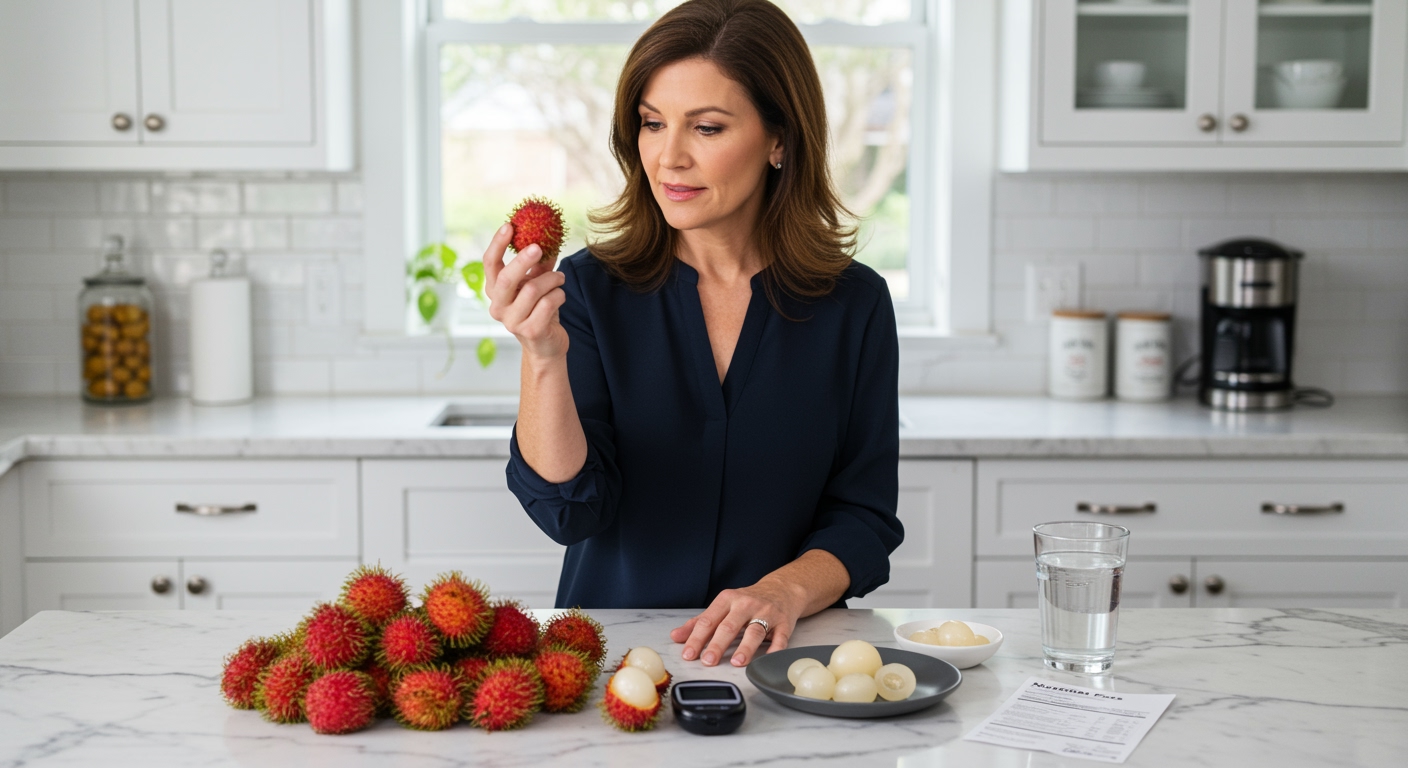✪ Key Takeaway: Rambutan can be safely enjoyed by people with diabetes when eaten in moderation due to its moderate glycemic index.
Introduction
You walk through the grocery store and spot those spiky red fruits that look like they came from another planet.
Your diabetes makes you question every food choice, and this exotic rambutan has you wondering if it will send your blood sugar through the roof.
Hi, I am Abdur, your nutrition coach and today I am going to explain exactly how rambutan affects your blood sugar and whether it deserves a place in your diabetes meal plan.
What Makes Rambutan Different From Other Fruits?
Rambutan belongs to the same family as lychee and longan, but it has some unique characteristics that set it apart.
This tropical fruit contains about 16 grams of carbohydrates per 100 grams, which puts it in the moderate range for fruit carb content.
The flesh inside that spiky exterior is translucent white and has a sweet-tart flavor that many people find refreshing.
What makes rambutan particularly interesting for people with diabetes is its fiber content of about 0.9 grams per 100 grams.
This fiber helps slow down sugar absorption in your digestive system, which can help prevent rapid blood sugar spikes.
The fruit also contains natural compounds called antioxidants that may help reduce inflammation in your body.
✪ Fact: Rambutan gets its name from the Malay word “rambut” which means hair, referring to its spiky appearance.
How Does Rambutan Affect Your Blood Sugar?
The glycemic index of rambutan sits around 59, which places it in the moderate category.
This means rambutan will raise your blood sugar at a moderate pace, not as quickly as high-glycemic foods like white bread or candy.
When you eat rambutan, the natural sugars get absorbed into your bloodstream over a period of time rather than causing an immediate spike.
The fiber content in rambutan acts like a natural brake system for sugar absorption.
Your digestive system has to work through the fiber to access the sugars, which slows down the entire process.
Research shows that eating moderate amounts of rambutan typically causes a gradual rise in blood glucose levels rather than dramatic peaks.
However, your individual response may vary based on factors like your current blood sugar control, medication timing, and what else you eat with the fruit.
✪ Pro Tip: Test your blood sugar 2 hours after eating rambutan to see how your body personally responds to this fruit.
What Is The Right Portion Size For Diabetics?
Portion control becomes crucial when you have diabetes, and rambutan is no exception to this rule.
A safe serving size for most people with diabetes is about 5-7 rambutan fruits, which equals roughly 100 grams.
This portion provides approximately 16 grams of carbohydrates, which fits comfortably into most diabetes meal plans.
You should count these carbs as part of your total carbohydrate intake for that meal or snack.
Timing matters just as much as portion size when it comes to blood sugar management.
Eating rambutan as part of a balanced meal with protein and healthy fats can help slow sugar absorption even further.
Avoid eating large quantities of rambutan on an empty stomach, as this can cause more pronounced blood sugar fluctuations.
✪ Note: Always consult your healthcare provider before making significant changes to your diabetes diet plan.
Are There Any Special Benefits For Diabetics?
Beyond its moderate glycemic impact, rambutan offers several potential benefits for people managing diabetes.
The fruit contains vitamin C, which supports immune function and may help with wound healing – both important considerations for diabetics.
Rambutan also provides small amounts of copper, manganese, and other minerals that support overall metabolic health.
Some studies suggest that the antioxidant compounds in rambutan may help reduce oxidative stress in the body.
Oxidative stress is often elevated in people with diabetes and can contribute to complications over time.
The natural anti-inflammatory properties of rambutan might also support better overall health outcomes for diabetics.
However, these benefits should be viewed as supportive rather than therapeutic – rambutan is not a treatment for diabetes.
✪ Fact: One serving of rambutan provides about 40% of your daily vitamin C needs.
When Should You Avoid Rambutan?
While rambutan can be part of a diabetes-friendly diet, there are certain situations where you should be more cautious.
If your blood sugar is already running high, adding any fruit including rambutan might push your levels even higher.
People with poorly controlled diabetes should focus on stabilizing their blood sugar before introducing new fruits into their diet.
Canned rambutan in syrup is definitely off-limits for diabetics due to the added sugars that can cause rapid blood sugar spikes.
Always choose fresh rambutan over processed versions to avoid unnecessary added sugars and preservatives.
If you take insulin or other diabetes medications, you may need to adjust your dosing when adding rambutan to your meal plan.
Some people may also experience digestive upset when trying rambutan for the first time, so start with a small portion to test your tolerance.
✪ Pro Tip: Keep a food diary to track how different fruits affect your individual blood sugar patterns.
The Bottom Line
Rambutan can be a safe and enjoyable addition to a diabetes-friendly diet when consumed in appropriate portions and as part of balanced meals.
The key to managing diabetes is not avoiding all fruits, but learning how to include them wisely in your overall eating plan.
I would love to hear about your experiences with rambutan or any questions you might have about incorporating exotic fruits into your diabetes management routine – please share your thoughts in the comments below.
References
At NutritionCrown, we use quality and credible sources to ensure our content is accurate and trustworthy. Below are the sources referenced in creating this article:
- PMC: Antioxidant and Anti-inflammatory Properties of Tropical Fruits
- FoodStruct: Rambutan Glycemic Index
- January AI: Rambutan Glycemic Index Information
- Nutrisense: What is a Rambutan





